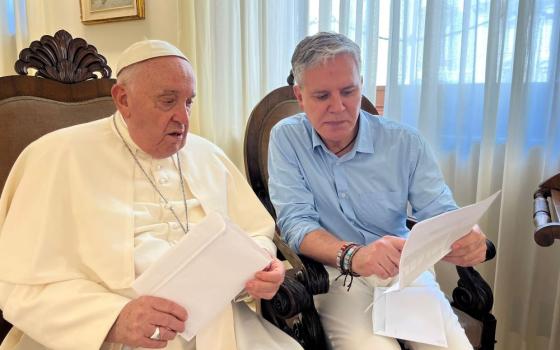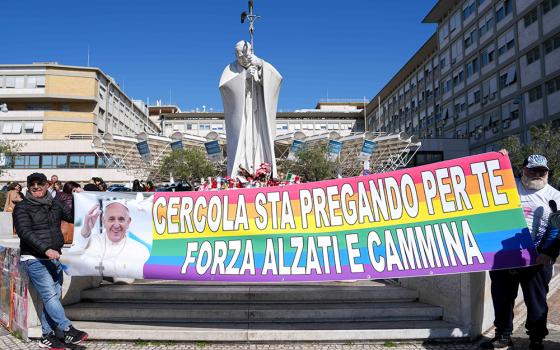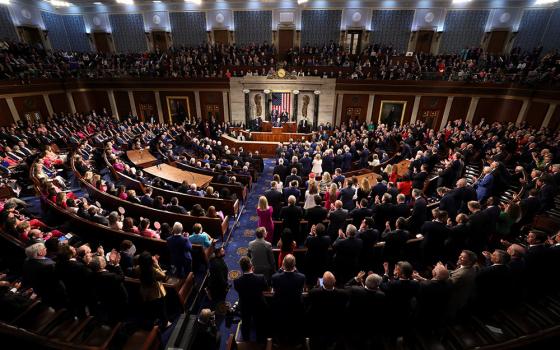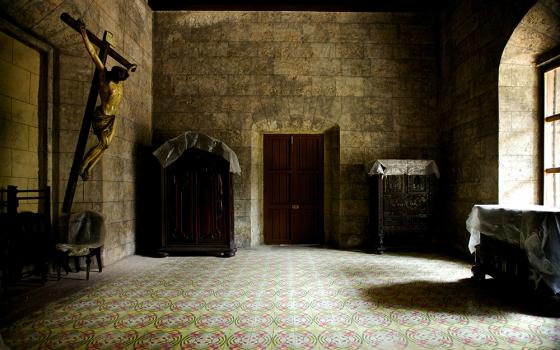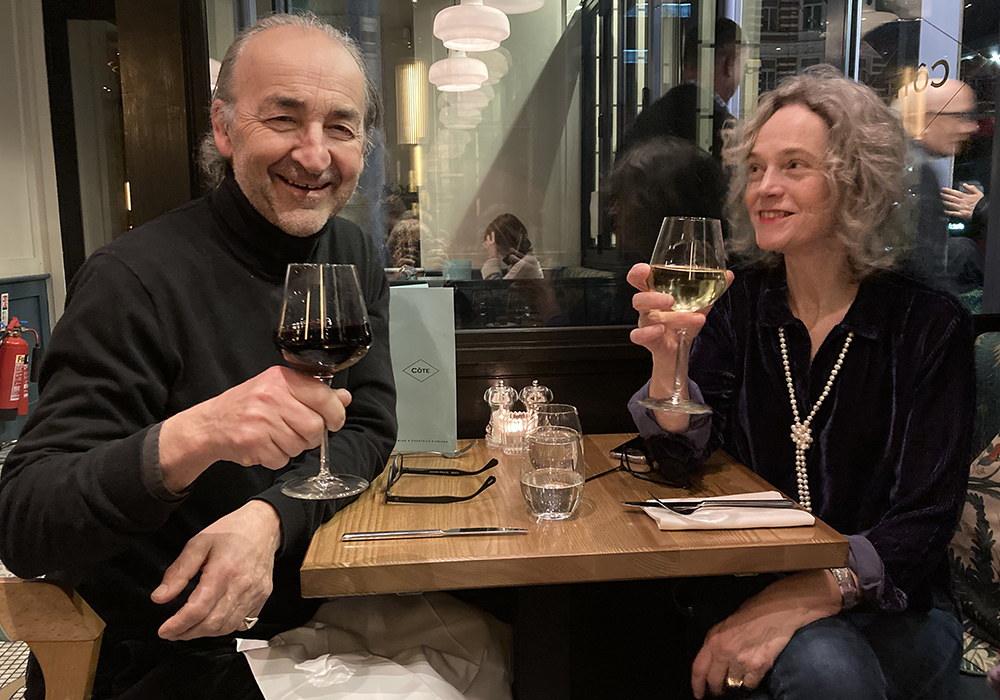
Fr. Clive Dytor is pictured with his wife Sarah. (Courtesy of Clive Dytor)
In a quiet corner of this Oxfordshire town, the small Catholic Church of St. Teresa of Lisieux, once a local laundry, stands above a narrow roadway, overlooking ancient cottages and tucked-away gardens.
When Fr. Clive Dytor took over as priest here in 2021, it marked the culmination of a career which had seen him honored as a war hero and lauded as head of a top Catholic school.
Since he'd also previously been an Anglican priest, he could welcome his wife and family to his parish Masses.
"There were some worries initially that having married priests might cause resentment, but people have been generous and it's seen as quite normal now," Dytor told NCR. "Although they couldn't run parishes at the beginning, that rule was later put aside. One of my joys now has been reconnecting with ex-Anglican friends who are now also serving as Catholic fellow-priests, many with wives as well."
Dytor is one of many married ex-Anglican clergy who quit the Church of England in the wake of its 1992 decision to ordain women priests and other liberal changes, and have since been reordained and integrated into Catholic parish life by special papal dispensation.
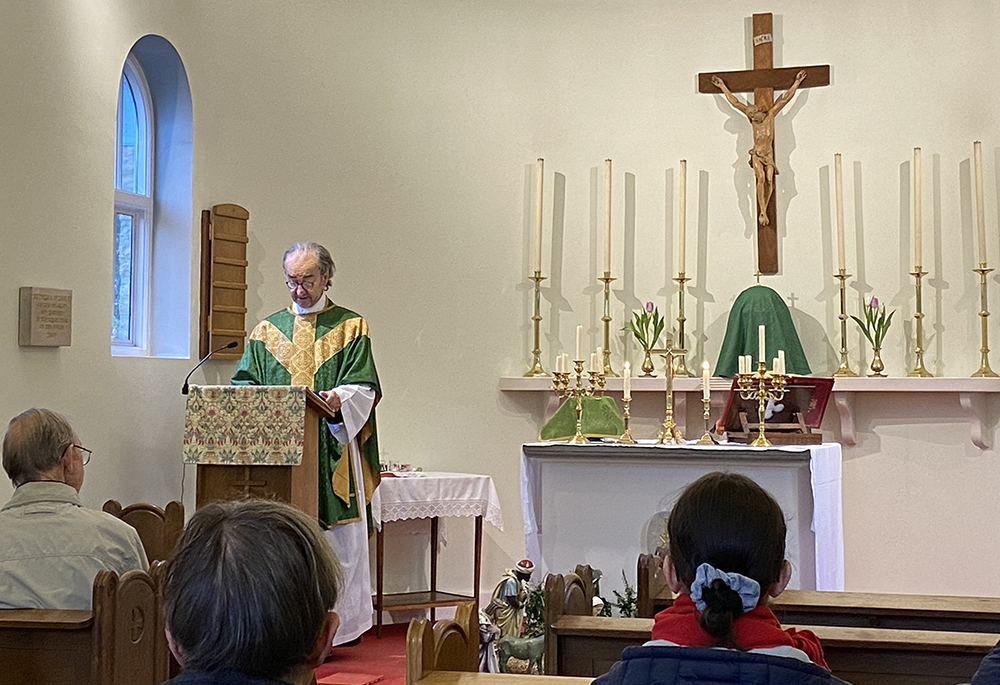
Fr. Clive Dytor is pictured at St. Teresa of Lisieux Church on Jan. 15 in Charlbury, England. (Jonathan Luxmoore)
While the bishops' conference in London doesn't keep figures, Dytor said married priests now make up 10% of the total in his own Birmingham Diocese, and a small but significant minority elsewhere, giving England the world's largest concentration of married Roman Catholic priests.
"Though I tried to resist the Catholic priesthood, the obstacles kept falling away — and after two years of part-time seminary training, I finally received Rome's permission," Dytor told NCR. "I'm always careful not to talk about my wife in front of single priests, while she also keeps a low profile. I think she enjoys being a Catholic priest's wife since no one expects her to be there in the first place."
Born and raised in Wales, Dytor was noted for sporting prowess while studying at England's prestigious Oxford and Cambridge universities, and joined the Royal Marines after completing his degrees.
He won the Military Cross for courage in the 1982 Falklands War after leading an overnight commando assault on an Argentinian machine-gun post at the Battle of Three Sisters, becoming a Church of England priest and school chaplain after leaving the army and training at Oxford's Wycliffe Hall.
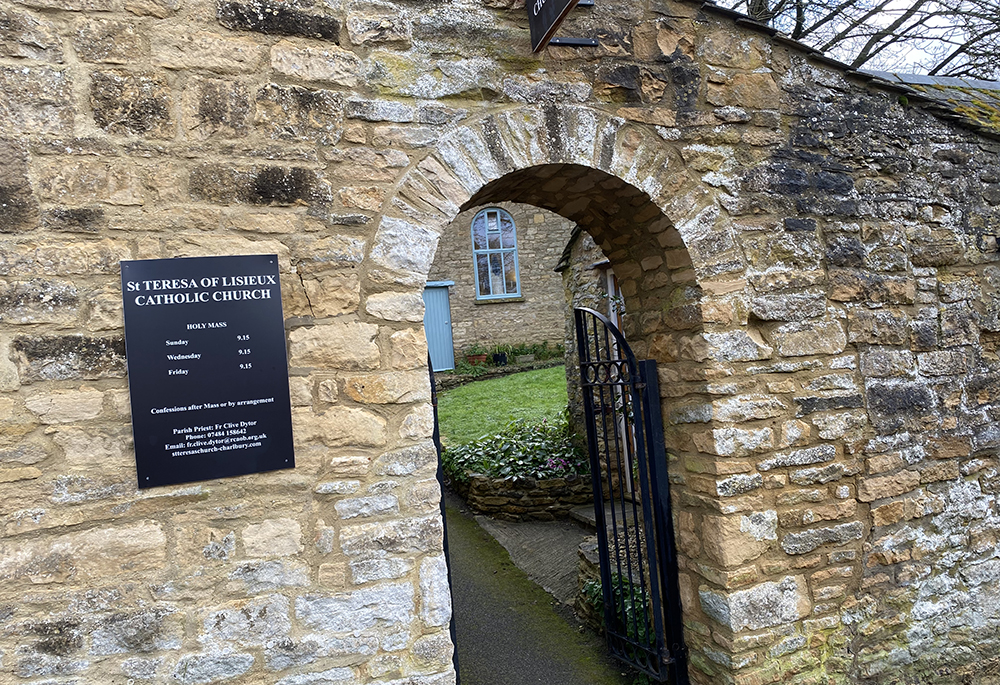
St. Teresa of Lisieux Church is pictured on Jan. 15 in Charlbury, England. Clive Dytor was ordained a Catholic priest by Archbishop Bernard Longley in Birmingham in September 2020, taking over St. Teresa's, Charlbury, and the neighbouring parish of Holy Trinity, Chipping Norton, in May 2023. (Jonathan Luxmoore)
Marrying Sarah Payler, a musician, in 1985, he gave up the Anglican priesthood and became a Catholic, later serving as headmaster of Reading's Catholic Oratory School, founded in 1859 by the Anglican convert St. John Henry Newman.
In 2015, aged 59, he resigned after completing the fabled Camino de Santiago pilgrimage across northern Spain, and was accepted for priesthood formation at St. Mary's College, Oscott.
Dytor was ordained a Catholic priest in the presence of his family by Archbishop Bernard Longley in Birmingham in September 2020, taking over St. Teresa's, Charlbury, and the neighbouring parish of Holy Trinity, Chipping Norton, in May 2023 after the retirement of its rector, Fr. Anthony Joyce.
Though initially worried that his married status could be viewed as unfair, Dytor says he's been well received by local Catholics.
That's been the experience of other married Catholic clergy too, who are thought to number around 300.
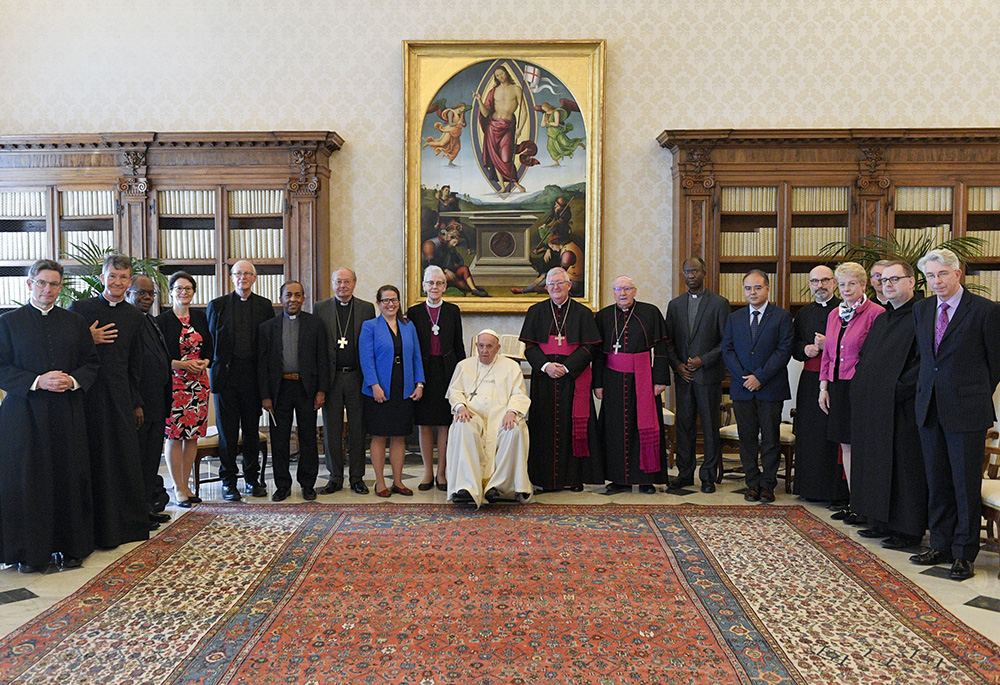
Pope Francis and members of the Anglican-Roman Catholic International Commission pose for a photograph May 13, 2022, in the library of the Apostolic Palace at the Vatican. At the left of the pope is Anglican Archbishop Linda Nicholls, the Anglican primate of Canada and Anglican co-chair of ARCIC; to the right is Archbishop Bernard Longley of Birmingham, the Catholic co-chair of the dialogue. (CNS/Vatican Media)
"Our parishes and chaplaincies have been served with dedication and great effectiveness for many years now by married priests and deacons," Longley, the archbishop of Birmingham, told NCR. "On the whole, parish communities have welcomed the married clergy I've appointed with sensitivity — and with great consideration for their family circumstances."
Fr. Peter Johnstone, a former Anglican parish vicar from London, left his church to become a Catholic during the first wave of conversions three decades ago, serving in the Arundel and Brighton Diocese after being reordained in 1999 by then-Bishop Cormac Murphy-O'Connor, England's later archbishop of Westminster and cardinal-primate.
He headed a Catholic parish at Midhurst for eight years before handing over at age 75 to another married former Anglican, Fr. Peter Newsam, and says he too has never faced disdain from lay Catholics or fellow clergy.
Fr. Peter Johnstone with wife Susan at their golden wedding anniversary (Courtesy of Peter Johnstone)
"Pope John Paul II authorized our bishops to receive and reordain ex-Anglican priests, leaving practical decisions to them," Johnstone told NCR. "Being married has never been an issue, and we've never been told to keep quiet about having families. On the contrary, we've always felt accepted as normal diocesan priests."
Although large numbers of ex-Anglicans became Catholics in the 1990s, disillusioned by the Church of England's apparent failure to abide by its traditional "reformed Catholic teaching," Britain's once-persecuted Catholic Church had long been accustomed to clergy with complex backgrounds.
Its Victorian-age primate, Cardinal Henry Edward Manning (1808-1892), an architect of papal infallibility, had been married and widowed as a young Anglican priest, as had Cardinal Thomas Weld (1773-1837), who had eight grandchildren from a marriage before his ordination.
In modern times too, the church has relied on priests from Ireland, Poland and other countries to make up numbers, and has long been accustomed to married Eastern rite clergy working across its parishes.
"It's been illuminating to see a generation of children growing up in presbyteries — in many cases, contributing to the local church with enthusiasm and generosity," Longley told NCR. "I'm also very grateful for the support and friendship shown to me and my auxiliary bishops by the wives of our priests and deacons, and I'm conscious of our duty of care towards the widows of priests who have themselves given so much support to the church's mission."
In 2011, Pope Benedict XVI created a special formation for ex-Anglicans wishing to become Catholics while also maintaining their own traditions.
Last June, the London-based Personal Ordinariate of Our Lady of Walsingham gained its first full bishop, when Msgr. David Waller took over from its previous ordinary, Msgr. Keith Newton, who was married with three adult children.
Advertisement
Buoyed by this new gesture of Vatican support, the Ordinariate now counts 11 former Anglican bishops and 90 mostly married priests as members, and enjoys links with separate ex-Anglican Ordinariates for North America and Australia, headed respectively by Bishops Stephen Lopes and Anthony Randazzo.
While its married priests must also obtain special permission, or a nihil obstat, from the Vatican's Dicastery for Doctrine of the Faith, here too they've been readily accepted.
"As in the United States and Australia, they've enhanced the diversity of the Catholic priesthood, and I've never sensed any ambivalence or animosity from more traditional clergy," explained Fr. Michael Halsall, the Ordinariate's episcopal vicar for vocations and formation.
"Parish life can be completely immersive for priests who are married, who have to be careful how they cope with the sometimes conflicting priorities of family life. But I think our bishops are well aware of this, and the issue or being married isn't even mentioned in the ordination service."
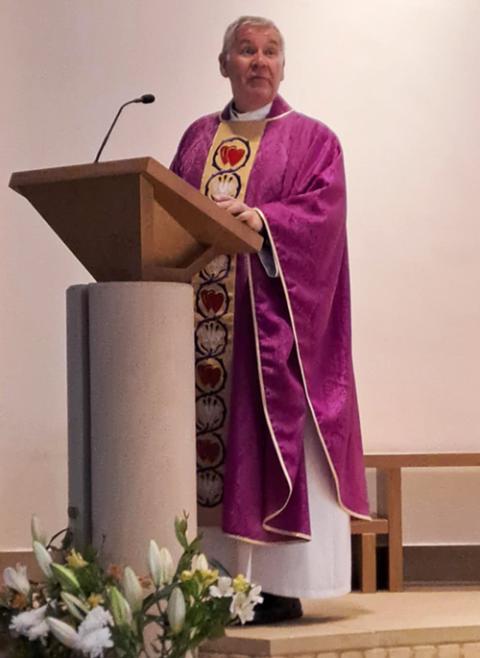
Fr. Michael Halsall, preaching at London's Allen Hall seminary on All Souls Day 2024 (Courtesy of Michael Halsall)
Could there be more married priests in future?
Some Catholics argue that Rome could relax the discipline of celibacy without impinging on essential doctrine, thus easing clergy shortages, loneliness problems and dangers of sexual abuse.
Others insist this is a simplification. Christian denominations who allow clergy to marry also face shortages and scandals, while the presence of priests with families can pose severe problems.
Whereas Anglican clergy in the wealthy Church of England are assured of salaries, houses and pensions, as well as generous allowances for schooling and transport, Britain's Catholic Church has no centralized finance system and forces its priests to rely on collections and donations.
For married ex-Anglican clergy with families, who became Catholics before they could receive Anglican payouts, this has created hardships, according to the now retired Johnstone.
While his own wife and children proved a "huge asset" in providing advice and support for his parish ministry, conditions have been a lot harder for younger priests.
Halsall, the Ordinariate vocations director, agrees.
Although a priest's wife may contribute with her own earnings, as well as providing the comforts of home life, the practical problems all militate against any wider future reliance on married Catholic clergy.
Over half of all married priests are now aged over 70, he points out, while the stream of Anglican priests wishing to become Catholics has now "reduced to a trickle."
Fewer Catholic priests are leaving to get married now than in the 1980s and 1990s, while Britain's Movement for Married Clergy, founded as a reformist pressure group in the 1970s, disbanded at Easter 2024.
"I don't sense that having married priests here in England has spurred demands for similar dispensations elsewhere — most priests seem content with their celibacy," Halsall told NCR. "This may be hard to understand for liberal Catholics who tend to see celibacy as an imposition and punishment. But the young seminarians I speak to are more likely to view it as a liberation."
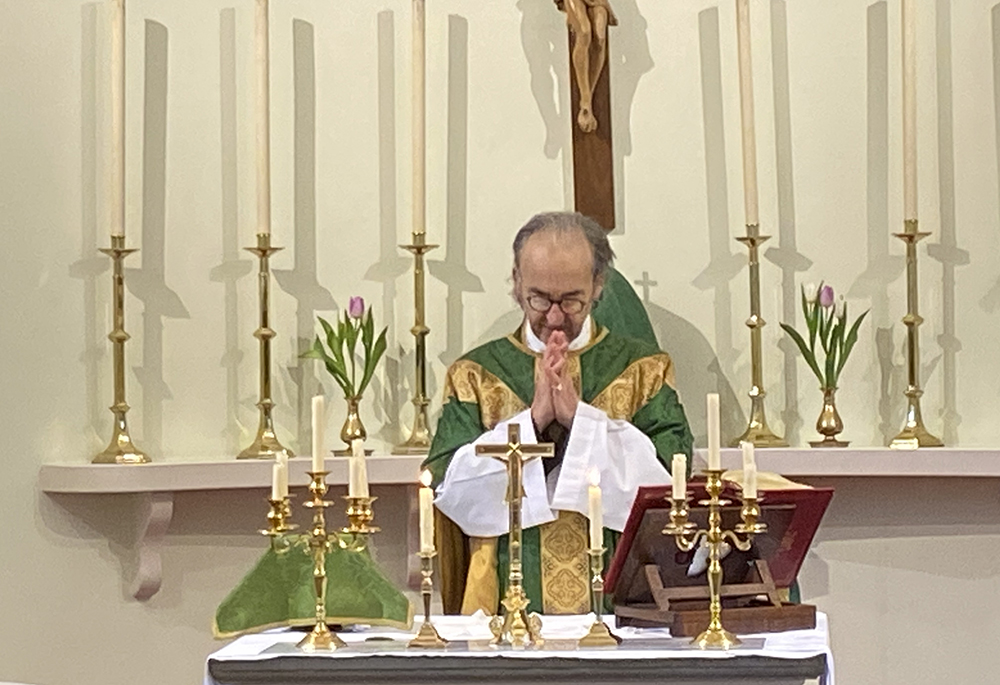
Fr. Clive Dytor is pictured at St. Teresa of Lisieux Church on Jan. 15 in Charlbury, England. (Jonathan Luxmoore)
Back at St. Teresa's, Charlbury, Dytor, now 68, is still getting used to his priestly duties, which include daily Masses and homilies, school services, house visits and regular diocesan and deanery meetings.
While the ex-Marine admits he's faced some tough challenges, his congregations are growing.
"Although this shouldn't in any way undermine single clergy who've been wonderful pastors and often great contributors to family life, laypeople here say they're glad to have a married priest," Dytor told NCR.
"While I'd have had difficulty living on my own in a presbytery, St. Paul reminds us in his First Letter to the Corinthians that married men will be anxious about worldly things. Far from being envious, most celibate clergy, free of problems with wives and children, seem to think we're the ones with the burdens."

